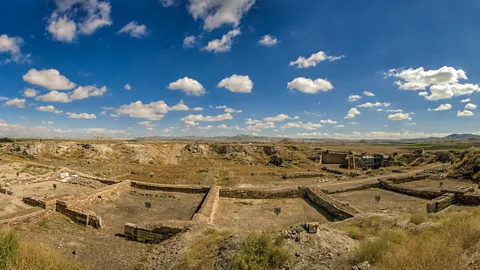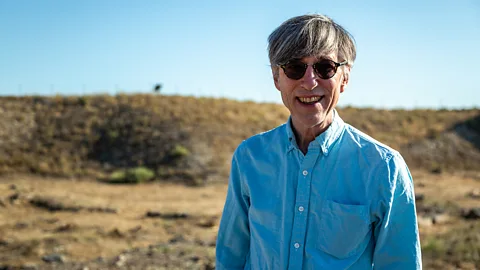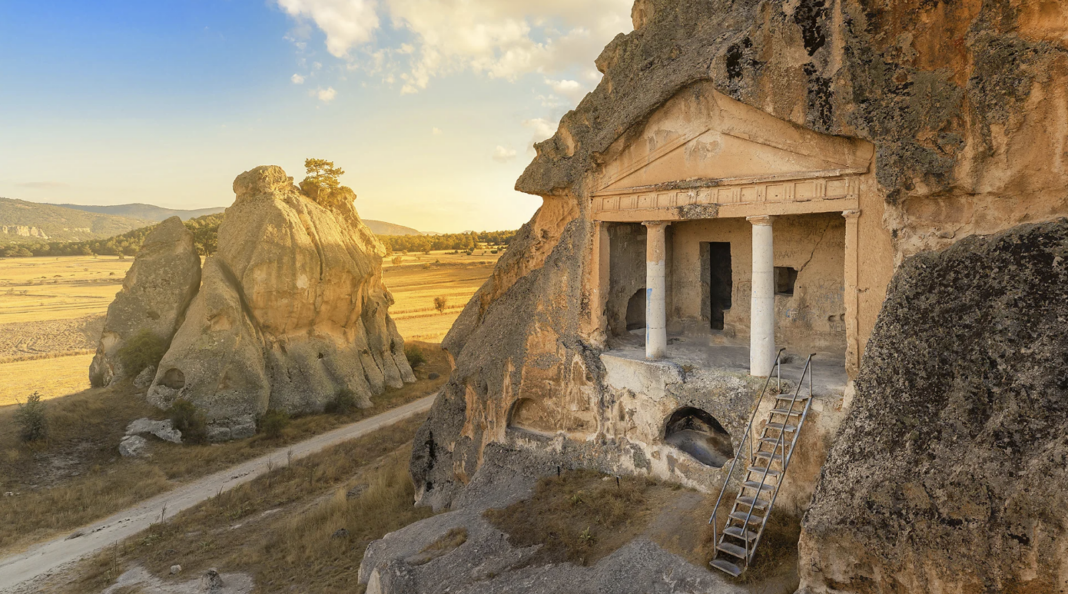Gordion, the ancient capital of Phrygia, was said to be ruled by the legendary King Midas, « the man with the golden touch ». But who was he, and where did the stories about him come from?
BBC, March 21, 2024, by Bella Falk
Visitors to Turkey have always been wowed by its magnificent historical sites. From the towering columns of the Library of Celsus at Ephesus to the colossal heads at Mount Nemrut, the country is almost sinking under the weight of its historical splendour.
But there’s one ancient city – recently crowned Turkey’s 20th Unesco World Heritage site – that announces its importance with far less fanfare. Its name is Gordion, the ancient capital of the Iron Age kingdom of Phrygia, and it’s at least 4,500 years old.
Located on a parched, windswept plain about 90km south-west of Ankara, Gordion looks more like a quarry or the collapsed crater of an extinct volcano than a once-powerful city. A huge mound, the buried remains of a citadel that covered 135,000 sq m, rises gently from the surrounding landscape with a sandy path leading to the top.
From there, you can peer down into the open excavations and make out the collapsed outlines of walls, marking the footprint of ancient mansions and warehouses like a property agent’s floorplan. Across the horizon, dozens of smaller mounds dot the fields like giant prehistoric molehills.
nly the monumental gateway, bracketed by massive stone walls 10m high, gives any indication that this was once the capital of one of the greatest kingdoms of the Iron Age.
« Many people haven’t heard of the Phrygians, but from about the 9th to the 7th Centuries BCE, they dominated Asia Minor – what is now Turkey, » explained Brian Rose, professor of archaeology at the University of Pennsylvania who has led excavations at Gordion since 2007.
« Gordion stands at the intersection of the major east-west trade routes: there were the empires of Assyria, Babylon and the Hittites to the east, and to the west were Greece and Lydia. The Phrygians were able to take advantage of this strategic location and became wealthy and powerful. »
 The ancient capital of the Iron Age kingdom of Phrygia, Gordion is at least 4,500 years old (Credit: CelCinar/Alamy)
The ancient capital of the Iron Age kingdom of Phrygia, Gordion is at least 4,500 years old (Credit: CelCinar/Alamy)
But while the name Phrygia might not be familiar, there’s one person associated with this city who many people may recognise. Archaeologists believe Gordion was ruled by the legendary King Midas, « the man with the golden touch ».
It’s a traditional cautionary tale: King Midas did a favour for the god Dionysus and in return was granted a wish. But rather than wish for something useful, the avaricious king asked for everything he touched to turn to gold. He immediately realised his error: food solidified before he could eat it, and when he hugged his daughter, she became a statue. The moral of the story is well-known: be careful what you wish for.
« The story isn’t literally true, » said Professor Lynn Roller from the University of California, Davis, who has studied Gordion since 1979. « But many myths have a core of historical accuracy, although they become distorted as they’re retold over the centuries. »
But who was Midas, and where does the idea of a « golden touch » come from? To separate fact from fiction, archaeologists first had to show that King Midas was a real person. The easiest way to do this was by looking at ancient texts.
« A Phrygian king named Midas is mentioned in several ancient sources, including annals of the Assyrian ruler Sargon II, » explained Roller. « The Assyrians considered him a powerful king and a major rival in their efforts to expand their territory during the 8th Century BCE. »
More evidence of Midas’s existence can be found about two hours west of Gordion, at a place called Yazılıkaya – more commonly known as « Midas City ». Rarely visited by tourists, it’s a dramatically beautiful hilltop site where volcanic formations jut from the landscape. It’s riddled with ancient caves and tombs, and 3,000-year-old staircases lead down into echoey tunnels hand-hewn from solid rock.
But the most dramatic of all the monuments here is a magnificent temple facade, 17m tall, carved into a rock face about 3,000 years ago. At the top, an inscription in ancient Phrygian reads: « Ates […] has dedicated [this] to Midas, leader of the army and ruler ». Proof, written in stone, that Midas was a real king, important enough for local lord Ates to pledge his temple to him.
« Since Midas was a powerful king, there’s a good chance he’s buried somewhere at Gordion, » said Rose. « Finding his tomb would be a hugely important discovery. And the obvious place to look was in one of the mounds that surround the city. »
More than 125 burial mounds, or tumuli, encircle Gordion, dating from the 9th to the 6th Centuries BCE. These giant earthworks, which look like alien hillocks on the otherwise flat landscape, were built to protect the tombs of important people from grave robbers, much like the Egyptian pyramids. The largest, a steep-sided peak now carpeted in scrubby yellow grass, stands 53m high, making it the second largest burial mound in Turkey. Experts estimate it took 1,000 people up to two years to build it.
 Experts estimate it took 1,000 people up to two years to build the Midas Mound (Credit: Chris Hellier/Alamy)
Experts estimate it took 1,000 people up to two years to build the Midas Mound (Credit: Chris Hellier/Alamy)
« Early archaeologists named it the ‘Midas Mound’ because they thought Midas must be buried inside. But they didn’t know for sure, » said Rose. « They had to be incredibly careful when they excavated it because it’s just a big pile of compacted earth. Get it wrong, and the whole thing can collapse on top of you. »
In 1957, working with a team of Turkish coal miners, experts carefully tunnelled into the mound. Inside, they found a large burial chamber constructed from pine and juniper logs, perfectly preserved inside its airtight cocoon for nearly 3,000 years.
Today, visitors can follow that same excavation tunnel deep into the mound to visit the tomb – the oldest wooden building still standing anywhere in the world. It’s so fragile that it’s now supported by girders and protected by a metal fence, but it’s still a hold-your-breath moment to lay eyes on this ancient structure that’s been hidden underground for so long – like a Turkish Pompeii, but nearly 800 years older.
The tomb’s occupant was a man in his 60s, lying on a collapsed bed and surrounded by bronze jars, decorated bowls and jugs, carved wooden furniture, fragments of fine cloth and other precious offerings consistent with the burial of a king. But was it Midas?
In the early 2000s, Gordion archaeologists turned to dendrochronology – tree-ring dating – for answers. But when they analysed the logs used to build the burial chamber, they hit a snag.
« The wood dates to around 740 BCE – but according to Assyrian records, Midas was still alive in 709 BCE, 31 years later, » revealed Rose. « This tomb cannot belong to Midas. »
So then, who is the man in the tomb? From the lavish burial he’s clearly a king, but which one? The date of his death can mean only one thing.
 Brian Rose has been working on excavations at Gordion since 2007 (Credit: Bella Falk)
Brian Rose has been working on excavations at Gordion since 2007 (Credit: Bella Falk)
« He probably died the year Midas came to power, » said Rose. « So, we’re pretty sure he must be Midas’ father, Gordias. »
Like his son, Gordias also became legendary. The story goes that when the previous king died without an heir, the townspeople asked the oracle for help. She declared that the next man to enter the city driving an ox cart should be made king. Moments later, Gordias, a farmer, drove into the city. He was crowned, and the city’s name was changed to Gordion in his honour.
To celebrate, his cart was displayed in a temple, tied with a complicated knot – the famous Gordion Knot. Legend said that any man who could untie the knot would rule Asia. Over the years, many people tried, but all failed.

